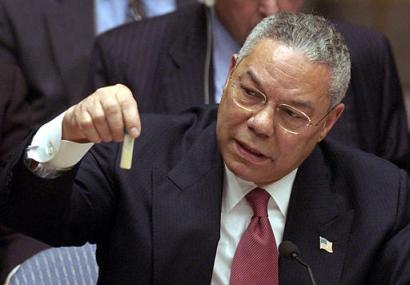
A “false flag operation” is a time-tested technique of intelligence services. It is the propagation of a vicious lie–the false attribution of a deed to the enemy–so as to justify war.
From the explosion on the Maine battleship in Havana Harbor in 1898 to the supposed attack on U.S Navy ships in Vietnam’s Gulf of Tonkin in 1964 to the bogus story of Iraqi anthrax in 2002, American advocates of war have falsely attributed heinous crimes to target regimes for the purposes of justifying U.S. military action.
Once the jargon of military and intelligence professionals, the term “false flag operation” has entered the American vocabulary. Thanks to Alex Jones, James Fetzer and other hucksters, “false flag operation” now signifies a treacherous machinations by unseen forces to dupe unwitting Americans. To call the massacre of schoolchildren a “false flag operation,” as Jones and Fetzer have done, is itself a vicious lie that treats the victims and survivors as an enemy, a demonstration of cruelty proven to drive traffic.
Because false-flag thinking is both a right-wing media meme and a reality of geopolitical struggle, distinguishing between the two is urgent more urgent than ever. It was no surprise that when two Persian Gulf oil tankers were attacked last Thursday, “Gulf of Tonkin” immediately spiked on Google, while right-wing sites played up claims of a false flag attack.

Secretary of State Mike Pompeo says a video of a ship, allegedly belonging to the Iranian Revolutionary Guard Corps, alongside one of tankers, is “unmistakable” evidence of Iranian responsibility. The attacks, countered Iran’s parliamentary speaker Ali Larijani, were “suspicious.”
“Suspicious acts in the Sea of Oman against oil tankers… seem to be supplementary to the [US] economic sanctions as the Americans went nowhere with the sanctions, [also,] especially, given America’s historical record in the area [of false flag ops],” Larijani said, according to Iran’s PressTV.

Russian government spokesman Dmitry Petsov recalled the “U.S. government’s claims in 2003 that Saddam Hussein had stockpiled “vials of white powder,” namely anthrax. The claims, which helped justify the disastrous U.S. invasion, were found to be false by the CIA.
The Russians and the Iranians aren’t the only one to suspect a ruse. Julian Lee, oil industry analyst writing in Bloomberg News, didn’t use the term “false flag” but he noted the timing of the attacks was most helpful to advocates of confronting Iran.
The attacks occurring during the visit of Japanese Prime Minister Shinzo Abe to Tehran, a visit blessed by President Trump. Abe urged Tehran to avoid conflict at all costs and pledged to do his utmost for a diplomatic solution. Then came an attack on a Japanese ship, Kokuka Courageous, which undermined and overshadowed his message.
Lee wrote:
This would seem very clumsy timing from a country seeing the first tangible signs of any easing of the crippling sanctions imposed by the Americans. But it is absolutely understandable if you’re someone whose ultimate goal is to derail any easing of tensions between the two nations, and to effect regime change in Tehran. Whoever is behind the attacks is no friend of Iran.
Until the United States and Iran document their conflicting claims with verifiable evidence, the issue of who was responsible cannot be decided. The video, by itself, proves nothing.
As Defense One observed
The boat’s clear and distinct connection to Iran or the IRGC, however, is not evident in the video itself. Nor is it clear from the video (1) where the boat came from, (2) who the occupants were, (3) whether what was allegedly removed was in fact a limpet mine (as the OSINT folks at Bellingcat pointed out this morning), or (4) where the boat went to after its occupants concluded their activity from the side of the Courageous.
Of course, the historical fact that false stories have proliferated as U.S. policymakers sought justification for war, doesn’t prove anything specifically about the tanker attacks in 2019, except that it would be naïve to reflexively rule out a false flag operation.
The Northwoods Paradigm

What is indisputable is that the U.S. government has turned to false flag operations to achieve strategic goals. Case in point. Operation Northwoods, a top-secret plan to create a pretext for a U.S. invasion of Cuba in the early 1960s. At the behest of the Joint Chiefs of Staff, Pentagon planners, assisted by CIA personnel, proposed a dozen different crimes that could falsely be blamed on communist Cuba.
Some of their schemes, as pitched by Pentagon planners.
- “A series of well-coordinated incidents will be planned to take place in and around Guantanamo to give genuine appearance of being done by hostile Cuban forces.”
- “A ‘Remember the Maine’ incident could be arranged in several forms: a. We could blow up a US ship in Guantanamo Bay and blame Cuba…”
- “We could develop a Communist Cuban terror campaign in the Miami area, in other Florida cities, and even in Washington.”
- “The terror campaign could be pointed at refugees seeking haven in the United States. We could sink a boatload of Cubans en route to Florida (real or simulated)…”
- “Harassment of civil air, attacks on surface shipping and destruction of US military drone aircraft by MIG type planes would be useful as complementary actions…” (After the reports of the tanker attacks last week, the Pentagon publicized the destruction of a U.S. military drone aircraft by Iranian-backed forces. )
The JCS unanimously approved the Northwoods plans in 1962 and 1963 and presented them to the White House. President Kennedy rejected the idea the first time, and ignored it the second. While never implemented, the Northwoods plans represented the Pentagon’s best thinking on how to carry out an “engineered provocation” at that time. The Northwoods documents are authentic, and the Defense Department has never disavowed the methods they espouse.
Made public for the first time in 1997, the 200-plus pages of Northwood material illuminate seven key goals of what the JCS called “pretext operations.”
Create indignation among Americans. Or as the JCS stated, “place the United States in the position of suffering justifiable grievances.”
Depict the enemy as a violent rogue actor: To make the bogus charges of terrorism stick, the Northwoods planners said, “Exploding a few plastic bombs in carefully chosen spots, the arrest of Cuban agents and the release of prepared documents substantiating Cuban involvement would also be helpful to projecting the idea of an irresponsible government.”
Contrive an “unprovoked” attack on the United States. The Northwoods planners said “It is possible to create an incident which will make it appear that Communist Cuban MIGs [Soviet-made fighter jets] have destroyed a USAF [U.S. Air Force] aircraft over international water in an unprovoked attack.”
Mimic real enemy actions, when possible. “Justification for U.S. intervention probably would be more convincing to the American public and rest of the world if it could be related to real and valid provocations rather than based wholly on manufactured cases which entail risk of compromise.”
Go to great lengths to generate false but incriminating detail. To stage a fake hijacking, the Northwoods planners suggested:
An aircraft at Eglin AFB would be painted and numbered as an exact duplicate for a civil registered aircraft belong to a CIA proprietary organization… At a designated time the duplicate would be substituted for the actual civil aircraft would be loaded with selected passengers, all board under carefully prepared aliases. The actual register aircraft would converted to a drone.
Take off times of the drone aircraft and the actual aircraft will be scheduled to allow a rendezvous south of Florida. From the rendezvous point the passenger carrying aircraft will descend to a minimum altitude and go directly into an auxiliary field at Eglin AFB where arrangements will have been made to evacuate the passengers and return the aircraft to original status. The drone aircraft meanwhile will continue to fly the filed flight plan. When over Cuba the drone will begin transmitting on the international distress frequency a MAYDAY message.”
If necessary, sacrifice human life to make the operation credible: In the Northwoods proposal to “sink a boatload of Cubans en route to Florida (real or simulated),” the merciless parenthetical shows that even people fleeing the target regime were considered potentially expendable to achieve U.S. goals.
Exploit the news cycle to promote false claims: In early 1962, the United States was preparing the launch astronaut John Glenn into space. Operation Dirty Trick would be mounted to “provide irrevocable proof that, should the MERCURY manned orbit flight fail, the fault lies with the Communists…This could be accomplished by manufacturing various pieces of evidence which would prove electronic interference.”
False flag operations, in other words, are not just a figment the conspiratorial imagination. They have also served as instruments of U.S. regime change policy. These tactics have never been repudiated by U.S. officials. They are a weapon in Washington’s arsenal.



